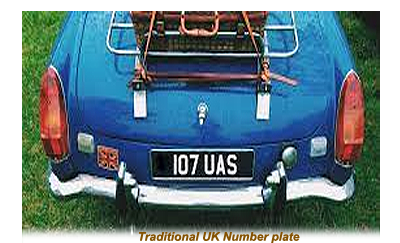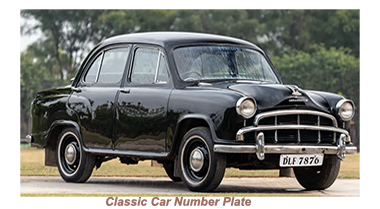
 Looking after a classic car's number plates is one of the least testing aspects that the person charged with it's maintenance will encounter, although it is a task that should never be taken lightly.
Looking after a classic car's number plates is one of the least testing aspects that the person charged with it's maintenance will encounter, although it is a task that should never be taken lightly.
Restorers, who are that way inclined, will spend a lot of time and money to make their classic car stand out from the crowd. And sometimes they even succeed to produce a car which is a real one of a kind.
Yet anyone who owns a classic alreadyhas a unique version of the model without the need to spending thousand to do so - the vehicle's number plate.
Everything goes in circles and a lot of people find the number plate of cars of the fifties and sixties and before extremely attractive, with large, embossed silver coloured letters against a black background set in an embossed silver frame.
From the Sixties and onwards that style of number plate gradually became passe with deep yellow backgrounds and small-scale black numbers becoming the norm.
With restrictions on number plate styles being consistently relaxed, all kind of configurations became commonplace with began to cause some confusion to the DVLA as well as the traffic police.
Nowadays when someone with an eye for detail wants to give his number plate a new lease of life, they have many options to choose from- from renewing their existing numberplate to finding a personal number and transferring it to the vehicle.
The registration numbers of cars registered before 1963 did not have an additional suffix to denote which year they first hit the UK roads. Before then registration plates contained a series of three numbers followed by three letters- for example 123-ABC. Going back even further the letters preceded the numbers i.e. ABC -123.
In the pre-war years registration numbers ran in sequences of to letters and four numbers i.e. 12-ABCD or even ABCD-12.

 The latter offered the most interesting possibilities as if someone got lucky they were handed a guaranteed way to personalise their car by having a number that resembled their name of nickname.
The latter offered the most interesting possibilities as if someone got lucky they were handed a guaranteed way to personalise their car by having a number that resembled their name of nickname.
It was only a matter of time before a little industry sprang up dealing in registration numbers. This procedure is perfectly legal, and monitored by the UK Licensing Authorities.
Nowadays someone who wants to round of their restoration project by stamping their individuality on their vehicle simply has to reach out to one of the companies who deal in number plates and check their list of numbers available.
There are endless possibilities and permutations, although the rarer the number the more expensive it can become.
Once the number has been acquired all that is required is to follow the simple procedures demanded by the Driver and Vehicle Licensing Agency (DVLA) which run as follows:
 So long as the plate followed these rules then it was deemed as legal .
So long as the plate followed these rules then it was deemed as legal .
 Fortunately restorers who want to ensure that their classic car will retain its authenticity and classic touch can still legally display the traditional black and silver number plate if car was registered before the end of 1974- even if the number was transferred from another vehicle.
Fortunately restorers who want to ensure that their classic car will retain its authenticity and classic touch can still legally display the traditional black and silver number plate if car was registered before the end of 1974- even if the number was transferred from another vehicle.




